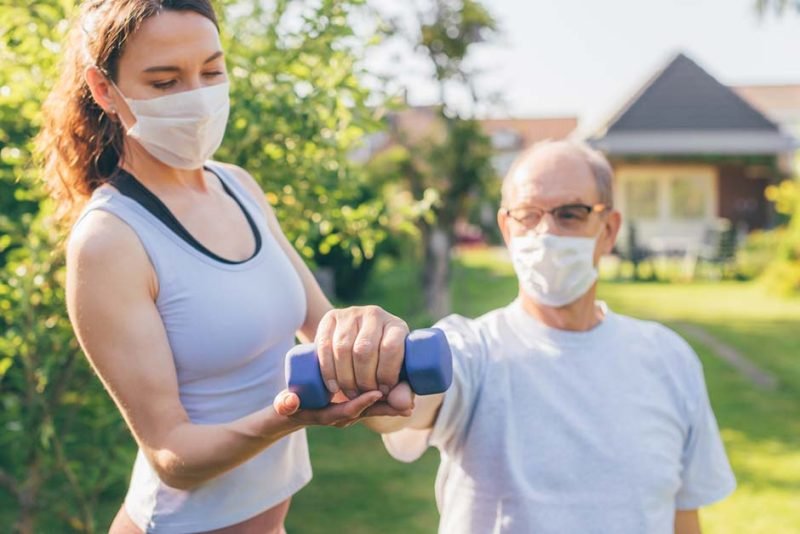
Mobility is a trendy term in the fitness world, but it’s important to note that the concept of mobility has been around for a long time. The capacity of a joint to freely move over a certain range of motion is the simplest definition of mobility. Great mobility implies that you have a smooth and pain-free range of motion. Having solid mobility is a great advantage as it allows you to perform exercises with better form, making your fitness journey more effective. It’s an area worth focusing on!
As you get older, you gain more experience and wisdom. It’s great to know that mobility can be improved through training! In addition to a more detailed description of mobility training in general, we’ve included seven mobility-focused routines for you to incorporate into your training below.
Exercises for limited mobility: 7 easy ways to stay active
Exercise in water
It is simpler to move around in the water. Your joints are under less stress. Additionally, it’s a productive approach to exercise even if you have mobility problems. According to recent research, working out in the water several times each week for eight to twelve weeks improved strength, balance, heart health, and overall fitness.
Use resistance bands.
Have you ever seen rubber resistance bands being used in physical therapy or a gym? For those with restricted mobility, resistance bands provide another safe and low-impact workout option. A resistance band may be used for several workouts to increase strength and balance, including:
Sitting rows
Squats
chest press
Biceps curl
Band Pull-apart
Strength training exercises.
Did you know that your health and quality of life can be assessed and predicted using your grip strength? Researchers have discovered that older persons with weak grip strength were more susceptible to physical deterioration.7 They also discovered a potential link between strong grips and long-term health.
Here is a quick exercise to strengthen your grip:
Obtain a foam, rubber, or tennis ball.
Using one hand, hold the ball.
Squeeze for 3 to 5 seconds using all of your might. Slowly release your grasp.
Sets of 10–15 squeezes per hand should be repeated.
Exercises like these that improve grip strength for those with restricted mobility can enable you to get stronger and assist daily activities like picking up and holding things or opening jars.
Flexibility exercises
Shoulders Extended Back Towards the Wall
The back-to-wall shoulder flexion exercise teaches the shoulder blades to flex and extend independently of the lower back. Lifting your arms above while doing this exercises your core stability, neutral neck posture, and posterior pelvic tilt.
Your feet should be around six to eight inches away from the wall’s base when you are set up with your back against it. Ensure that your back is flat and that your thumbs are pointing forward. When you attempt to contact your thumbs with the wall without using your lower back to compensate, steadily lift your arms upward as you exhale. Then start again from the original spot and repeat.
Chair Dips
You can still be active even if you have difficulty walking or climbing stairs. You may do the following by using your chair to strengthen your upper body:
* Use an arm-supported chair.
* Your feet should be level on the floor and separated by your shoulders. With your hands, hold the chair’s arms. Breathe in as you lean a little forward.
* Breathe out as you progressively raise your arms-only body off of the chair while maintaining a straight upper body.
* Hold your position for one second, then lower yourself back into the chair and take a deep breath.
* Perform sets of 10–15 repetitions with brief rest periods in between.
Chest Stretch
Getting on the floor to do push-ups to build your chest could be too difficult if you have restricted mobility. However, you can still work out your chest while seated in a chair. This is how:
* Take a seat in an armless chair. Stretch your arms out to your sides with the palms of your hands facing front.
* Stand with your feet shoulder-width apart and flat on the floor.
* Ease your arms back. Feel your shoulder blades slide towards one another.
* Take a moment to stop and hold the stretch for 10 to 30 seconds.
Three to five times should be repeated.
Also, Note that It’s okay if you begin to experience pain in your body during or after a workout. This discomfort is normal. But don’t worry; we’ve got you covered with Golden Revive Plus, the best joint pain supplement available on the market. Golden Revive Plus is a joint pain supplement designed to assist in easing joint pain and stiffness. The dietary supplement has also undergone clinical testing to assist in enhancing movement and minimizing discomfort.
Benefits of Exercise for Limited Mobility
- Improved Heart Health: By increasing blood circulation and lowering cholesterol levels, exercise may help lower the risk of heart disease, stroke, and other cardiovascular disorders.
- Increased Strength: For those with restricted mobility, exercise may assist increase muscular strength, coordination, and balance.
- Enhanced Mobility: Exercise may increase flexibility, balance, and range of motion, making it simpler to move about.
- Better Mental Health: Exercise may make you feel happier, less stressed and anxious, and live a more fulfilling life in general.
- Better Balance: Exercise may aid with coordination, balance, and stability, which helps lower the chance of falling.
- Less Pain: Exercise may help lessen pain from chronic illnesses including osteoarthritis and joint discomfort.
- Higher Quality of Life: Benefits of exercise are related to mood enhancement, stress reduction, and higher quality of life in general.
How To Track Mobility Progress
Tracking your daily exercise levels can help you see how they fluctuate over time. Track your steps, calories burnt, and other data with a fitness tracker or app.
- Calculate Range of Motion: Using easy activities like reaching, extending, and bending, keep a record of your range of motion. As your flexibility increases, keep track of your development and see how your range of motion changes.
- Track your strength training progress with repetitions and sets by keeping a strength and endurance journal. Keep track of your repetitions and sets to see how your strength and stamina develop over time.
- Assess Balance: To gauge your coordination and balance, use a balance board. Keep track of how long you can stay balanced and how it changes over time.
- Evaluate Functional Mobility: Determine how your mobility impacts activities of daily living including jogging, stair climbing, and walking. Observe how your mobility changes over time as you engage in various activities.
Conclusion
People at all stages of life may benefit greatly from joint mobility in terms of function. In addition to being helpful for older persons with arthritis or joint discomfort, it is a crucial component of a workout for athletes or gym enthusiasts.
Additionally, as was already mentioned in this article, you can always turn to supplements for additional pain relief. For more information, see the Golden Revive Plus Review in the Health web magazine.
Don’t allow restricted mobility to hold you back now that you know the finest mobility exercises to help you move and feel better. You are still capable of acting. It’s crucial to encourage excellent health. Look for activities you can undertake. Or, seek advice from your physician. Even little exercise may benefit your health, help you live longer, and prevent and manage illness.









